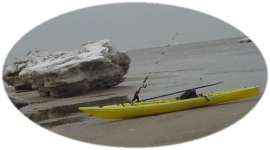
Kayaking with Icebergs
William G. McArthur, January 5, 2001

We finally got some decent weather today after weeks of freezing temperatures and howling winds. The Delaware Bay three miles north of the Cape May Canal near Baie-Chalet was ice for a quarter of a mile off the beach. On the positive side, we did get a gorgeous sunset over the ice the other night, but it's been a chore to play outside (it's always a chore to work outside). This morning the temperature rose to 34° by just after dawn and the ice had broken up into icebergs. The southeast wind was a tolerable 5-10 mph. In other words, there were good paddling conditions! To make things even better, it was within an hour of low tide so launching and landing wouldn't be a problem. I remember too well a day last year when I couldn't safely launch from a six foot ice cliff in front of the house; but it was near high tide then. The water was reasonably calm (click here for a short clip) and a cool 30° as I launched my kayak. I brought my fishing pole in case I might encounter a cold water fish that was desperate enough to go for my trolled lure.There are a number of safety issues involved in paddling with icebergs in 34° air and 30° water. I decided a few years ago to wear what the winter surfers wear when they brave the frigid waves. So, my basic piece of clothing is a 5 mm wetsuit worn with nothing underneath. I've found that the "zipperless" style of wetsuit is the best for kayaking because the extreme elasticity at the top provides plenty of freedom for paddling. I wear a pair of thin neoprene socks on my feet under the cuffs of the wetsuit. After donning the wetsuit, I put on a pair of surfer booties over the socks. My wetsuit has a hood for the coldest days, but I like to wear a knit cap instead if I don't think I'll be dunked. My hands are always my weak point. I've found that surfer "lobster claw" gloves are tolerable, but they're kind of heavy and clumsy. I'm wearing a pair of neoprene Titanium TS Warmers this year and find them very acceptable. I also have a pair of pogues to put over the gloves on the worst days. I've found that I don't need any special protection for my face even when I get immersed. A PFD should be worn over the wetsuit, but I must admit that I sin in this area and omit this essential item of safety gear. It is too dangerous to paddle when the temperature falls below 29° because water can freeze on your paddle and kayak; worse, you can get trapped in newly formed ice. You need to be very aware of the current and how it will run while you are on the water. Remember the saying "tip of the iceberg"; the truth is that the majority of the ice is under water, and it could broaden underneath. Be careful when you paddle close to a berg; the paddle you break could be your only one (carrying an extra paddle always makes good sense). Unless you're going to drift with the ice flow, the size and distribution of the icebergs will change as you move. If you get too tightly packed among the ice blocks, you'll find it difficult to paddle. I discovered the hard way one day that paddling in slush is as difficult as it sounds, so I'd advise against it. You will probably bump into some ice, so use a plastic kayak that can take a good hit.
It was a lovely paddle. I trolled fruitlessly as I paddled into the SE breeze. One of the best aspects of winter kayaking is the silence. There are no boats (other than an occasional ferry) to provide noise pollution. In the summer, I'd like to equip my kayak with surface-to-surface missiles to blowup the pesky jet skis that buzz aimlessly around the Bay. Judging by the profiles of the typical jet-skiers that I see, they'd be far better off to pursue something active on the water like swimming or paddling to raise their fitness levels and lower the noise level. I saw a red-tailed hawk soaring over the dune line searching for something to eat. As far as I've seen, only rabbits are available as meals during the daytime when it's this cold. The only other birds that I saw today were Gulls, both Herring and Black-backed. The Herring Gulls were pretty active, so I guess they were finding food, but I confess that I don't know what they are finding to eat when the water is near freezing. I was blocked by a thickening ice flow after 2.5 miles, so I completed a leisurely 5 mile round trip. I was very grateful to get out on the water again after such a long interval (my last paddle was on December 22). After I got into the house, it started to snow lightly.
I've been a student of Astanga Yoga for almost two years. One of the key concepts of Yoga and, more generally, of Eastern philosophy and religion, is attempting to "be in the moment." Over the years I have found that doing something mildly dangerous has the capability of raising the awareness level toward the goal state. Again today, as I looked for hidden ice and attempted to figure out the passages through the flow, I found my consciousness moved drastically toward the present.
